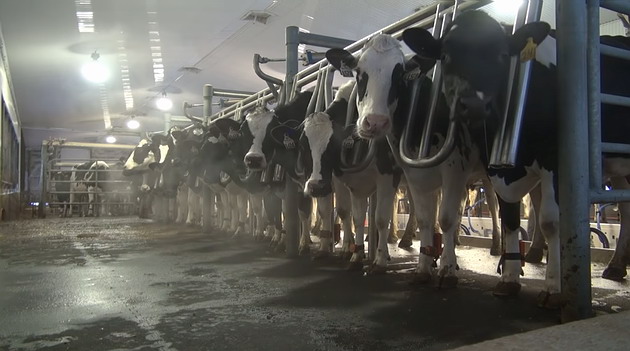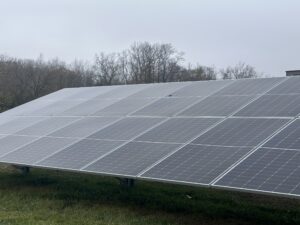Biomass Energy Definition

To define biomass energy we first need to explain that biomass mostly consists of wood and plant waste, agricultural waste, energy crops, organic waste produced by farms, animal fats and vegetable oil, residential waste and garbage, etc. which can be used as fuel to generate electricity instead of using fossil fuels such as coal, oil and natural gas.
When burning solid fossil fuels like coal in power plants we generate steam to spin a turbine for energy generation, but we also generate a very large amount of greenhouse gas emissions that are affecting our life and the environment.
By replacing coal with biomass, the power plant will generate steam to spin the turbine, but will release a way smaller amount of emissions (less toxic), which means that biomass energy is a low-carbon energy source.
What is Biomass Energy?
Biomass is a renewable resource that uses wood and plant waste, agricultural waste, energy crops, organic waste and garbage to generate low-carbon energy.
Being produced mainly from wood and plant waste, agricultural waste, energy crops, organic waste, animal fats and trash (which is produced by people and companies every day), biomass energy is considered a renewable energy source because trees and plants regrow, while garbage and organic waste are both produced daily.
Biofuels represent cleaner fuels produced from biomass such as food crops, energy crops, wood waste (lignocellulosic biomass), agricultural waste, commercial, domestic, and in some cases even industrial waste, and they can be used as an alternative to gasoline, diesel and kerosene because they burn cleaner than fossil fuels.
Types of Biomass Used to Produce Biofuels
Biomass is used today to produce alternative fuels for the transportation sector (biofuels) because they burn releasing a smaller amount of emissions into the atmosphere, and is also used as an alternative to coal in biomass-fired power plants for electricity generation.
1. Agricultural crops and agricultural waste materials
This type of biomass is used as fuel, but also to produce a biofuel called ethanol (from corn).
2. Animal manure and human organic waste
This organic waste is collected in digesters and used to produce biogas (contains mostly methane), which can be used as a cleaner fuel than natural gas.
3. Garbage and food or yard waste
Garbage and wood waste is burned in power plants for energy generation, and organic waste is used to produce biogas.
4. Wood waste and energy crops
These are mainly used as an alternative fuel to coal in biomass-fired power stations for large scale energy generation.
How is Biomass Produced?
1. Biomass and biofuels
Biomass is produced from wood and plant based waste materials such as (tree branches, plant waste, energy crops, agricultural waste, etc.).
Biofuels such as ethanol is produced from the fermentation of food crops like corn, and other crops such as sugarcane, hemp and switchgrass.
Lately, we are also producing ethanol from lignocellulosic biomass (poplar trees) to keep corn for the food sector (human and animal consumption), and not for the production of biofuels.
Biofuels such as biodiesel and bioethanol can also be produced from oil released by algae.
2. Municipal Solid Waste
Municipal solid waste known as garbage or trash, is a great source of recyclable materials, but is also used as fuel for biomass-fired power stations.
Plastics recycled from trash are used to produce new plastic-based products such as pipes and specialized pallets (HDPE bottles), flowerpots and buckets (PP plugs), clothes (sweaters) and lawn furniture (PET bottles).
Burning garbage instead of fossil fuels for energy generation is a more efficient and sustainable activity because we are releasing a smaller amount of emissions into the atmosphere (compared to coal), and we are also cleaning the landfills, which would otherwise sit for decades in the same place and would heavily pollute the soil located underneath and around the landfill.
3. Paper Waste
Paper is mostly produced from wood, and this is the reason why paper is a great source of waste for biomass.
By recycling paper, we are turning this resource into biomass, which can be used as fuel for residential heating or can be used to produce new sheets of paper or cardboard.
4. Animal and Vegetable Fats
Waste animal fats and vegetable oil produced daily by the food industry (restaurants and fast foods) represent a great source of biofuel (biodiesel), which can be used in diesel engines for a cleaner and cheaper ride that smells like fries or doughnuts.
How is Biomass Used for Energy and Heat Generation – Thermal Conversion
Biomass is used to produce energy through thermal conversion, which means that the biomass feedstock (municipal solid waste, waste paper and waste wood) is heated to burn (and produce steam) to dehydrate or to stabilize it.
Before burning, biomass needs to be dried using a process called torrefaction (increases the energy density of the biomass by removing moisture), and after this process the dried biomass is compressed intro briquettes.
Biomass briquettes
Biomass briquettes can be stored easily because they are hydrophobic (repel water).
Due to the high energy density of the biomass briquettes, they can be burned easily during direct firing or co-firing.
Through direct firing, biomass briquettes are burned directly to produce steam that will spin a turbine and generate electricity using a generator, or the heat produced by burning biomass will be used for residential heating.
Through co-firing, biomass is combined with a fossil fuel (coal) in coal-fired power plants, which eliminates the need to build new power plants (biomass-fired power plants), and reduces the use of coal for a cleaner air.
Pyrolysis
Biomass can also be heated through pyrolysis, a process in which biomass is heated without the presence of the oxygen (up to 570° F or 300° C) to prevent burning.
Using pyrolysis, biomass is chemically altered and turned into a dark liquid called pyrolysis oil, syngas (a sinthetic gas) and biochar (a solid residue of biomass).
All these components obtained from biomass through pyrolysis can be used for electricity generation and to produce fuels and plastics (pyrolysis oil can be used as a replacement for petroleum), or as an alternative to natural gas (syngas is converted into methane), or to enrich soils in the agricultural sector (biochar).
Gasification
Biomass can be directly converted into energy using a process called gasification.
Gasification involves heating a biomass feedstock such as municipal solid waste up to a temperature exceeding 1,300° F (700° C) in a controlled volume of oxygen to prevent burning the waste, and break down its molecules to obtain syngas and slag.
Consisting of hydrogen and carbon monoxide (CO), syngas is cleaned through gasification of any traces of sulfur, particulate matter, mercury or other pollutants.
Syngas is then used as fuel for electricity generation, as a heating source, or is processed to become chemicals, fertilizers or biofuel for the transportation sector.
Slag is used to produce cement, asphalt and shingles.
Anaerobic Decomposition
Anaerobic Decomposition is another process specific to landfills, ranches or farms.
In landfills, biomass and organic waste decays and produces methane through anaerobic decomposition, and if collected, can be used to replace fossil fuels like natural gas.
Modern ranches and farms are usually collecting the organic waste produced by their livestock (cow manure or other type of organic waste) in large digesters to produce methane through anaerobic decomposition, and use this gas instead of natural gas to generate electricity that will power the farm and maybe even some homes in the area.
Large farms can produce an impressive amount of organic waste which can be used to generate a a huge amount of methane, which is able to power the farm and even a small community (hundreds of homes) with cleaner energy.
Biomass and Nature
Biomass and biofuels are all produced using natural resources available on the planet such as wood, or produced by people and animals (organic waste) and trash (Of course that we don’t have to cut trees to produce biomass, the number of trees on the planet needs to be increased to decrease the level of carbon in the atmosphere).
It is more than obvious that we need to turn wood and plant waste, energy crops, agricultural waste, trash and organic waste into something useful because for our society because this way we are recycling a lot of materials, we are turning waste into greener energy, and we are cleaning the garbage produced on the planet.
To understand how important is to turn municipal waste (trash) into useful materials and energy, you only need to visit a country where this is not possible (due to obscure interests of some local authorities), and you will quickly understand that such a country is overwhelmed by landfills, bad smell and diseases.
Conclusion
Waste needs to be recycled and turned into useful energy because only this way we can keep the planet clean and reduce the use of fossil fuels for a cleaner and healthier environment for all of us.







